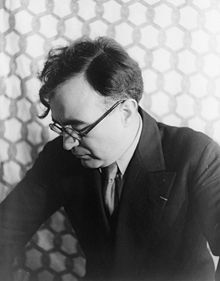
Piano Sonata No. 3 is a solo piano work written in 1928 by the Mexican composer Carlos Chávez.
History
Chávez composed his Third Piano Sonata in New York during January and February 1928, and dedicated the score to Aaron Copland. [1] The composer himself gave the first performance at the Edyth Totten Theatre in New York on 22 April 1928, on the first of the Copland-Sessions Concerts. [2] [3] Although he had composed two piano sonatas previously, the score was first published simply as "Sonata for Piano" in the January 1933 issue (vol. 6, no. 2) of Henry Cowell's New Music Quarterly. [4]
Analysis
The sonata is in four movements:
Angular melodies, a percussive approach to the instrument, employment of stark and concise one- or two-measure units, abrupt changes of register, rhythmic irregularity, and a harmonic profile that blends frequent vertical seconds, sevenths, and ninths with sudden, stark octaves are the leading features of the sonata. Chávez deliberately avoids overtly expressive elements, but uses a fundamentally diatonic polyphony which does not prevent him from achieving the harshest sonorities. [1] [5] The sonata adheres to a neoclassical aesthetic, linked to notions of simplicity, balance, and purity, though not resembling very closely the European (Stravinskian) model of neoclassicism. [6]
The short first movement serves as a kind of slow introduction in two main sections, which may be viewed either as a simple double exposition, [1] or as an adaptation of binary form, with a short transitional passage inserted between the two parts in b. 33–39. [7] [8] There is no conventional thematic development. Instead, Chávez builds the movement from discrete rhythmically based patterns: the first is two bars long, the second is three bars with a corresponding expansion of the pitch range, and the third increases further to four measures and adds a rocking figure in the left hand. Transformation and repetition of these patterns cumulate into a tight construction of cellular units. [9] At the same time, a four-note pitch cell (F♯/G, C, F), introduced in the right hand, is repeated numerous times, mostly untransposed (except by octaves) and always in the same rhythm. [8]
The second movement functions as the allegro proper, with a double exposition. It is characterised by a free contrapuntal texture, almost always in two voices, and a fluctuating polyrhythm, with superposed groups of two, three, and four diversely varied figures. The meter is constantly in flux, and tonality is not clearly defined, producing a modal quality. [1]
The third movement is a slow and enigmatic fugue in four voices. [10] The writing reflects the composer's preference at this point in time for pure, absolute music, free of any suggestions of philosophical, literary, or plastic imperatives. [1]
The fourth movement, in rapid tempo and at first in a steady triple rhythm, combines the functions of
finale and
scherzo. In its intricate, jazz-like syncopated rhythms and abundance of large melodic leaps it is close in character to two piano pieces Chávez wrote in the same year: Blues and Fox. With hard contours and acerbic tone, it features the extreme ranges of the instrument. Like the first movement, it is built in superimposed patterns of short, incisive motives. After the opening section, the meter constantly changes, as in the second movement, and features unusual time signatures such as 1
12, 2+1⁄2
4, 3+1⁄2
4, and 4+1⁄2
4.
[11]
[12] Formally, the movement falls into four roughly equal sections and resembles a
variation form.
[13]
References
- ^ a b c d e García Morillo 1960, p. 64.
- ^ Downes 1928.
- ^ Oja 1979, p. 277.
- ^ Oja 2000, p. 278.
- ^ Oja 2000, pp. 275–276.
- ^ Oja 2000, p. 279.
- ^ Nordyke 1982, p. 41.
- ^ a b Vilar-Payá 2015, p. 120.
- ^ Oja 2000, p. 276.
- ^ Nordyke 1982, pp. 52, 66.
- ^ García Morillo 1960, p. 65.
- ^ Chávez 1972, pp. 16–20.
- ^ Nordyke 1982, pp. 57–58.
Cited sources
- Chávez, Carlos. 1972. Tercera Sonata. Colección Arión, no. 119. México, D.F.: Ediciones Mexicanas de Música.
- Downes, Olin. 1928. "Music: Presenting American Composers". New York Times (23 April): 20.
- García Morillo, Roberto. 1960. Carlos Chávez, vida y obra. México: Fondo de Cultura Económica. ISBN 968-16-0222-6.
- Nordyke, Diane. 1982. "The Piano Works of Carlos Chávez". PhD diss. Lubbock: Texas Tech University.
- Oja, Carol J. 1979. "The Copland-Sessions Concerts and Their Reception in the Contemporary Press". The Musical Quarterly 65, no. 2 (April): 212–29.
- Oja, Carol J. 2000. Making Music Modern: New York in the 1920s. Oxford and New York: Oxford University Press. ISBN 978-0-19-516257-8 .
- Vilar-Payá, Luisa. 2015. "Chávez and the Autonomy of the Musical Work: The Piano Music". In Carlos Chávez and His World, edited by Leonora Saavedra, 112–33. Princeton: Princeton University Press. ISBN 978-0-691-16948-4.
Further reading
- Citkowitz, Israel. 1933. "Winter Music, New York, 1933". Modern Music 14, no. 2 (March–April): 155–57.
- Rosenfeld, Paul. 1932. "American Composers VIII: Carlos Chavez". Modern Music 9, no. 4 (May–June): 153–59.
- Weinstock, Herbert. 1936. "Carlos Chávez". The Musical Quarterly 22, no. 4 (October): 435–45.